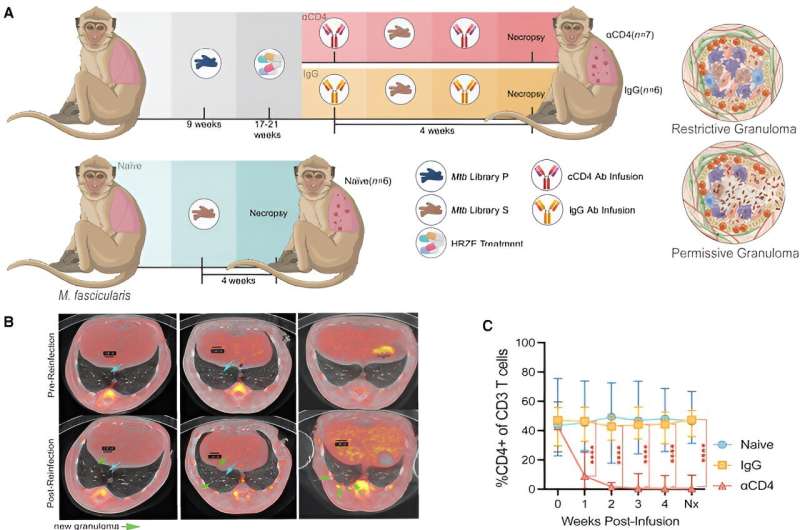This article has been reviewed according to Science X's editorial process and policies. Editors have highlighted the following attributes while ensuring the content's credibility:
fact-checked
peer-reviewed publication
trusted source
proofread
Immune protection against tuberculosis reinfection driven by cells that dampen lung inflammation, shows study

The body's first line of defense against tuberculosis (TB) involves immune cells that suppress lung inflammation instead of activating it, report University of Pittsburgh and the Ragon Institute of Mass General, MIT, and Harvard scientists in Immunity.
The research showed that a subset of infection-fighting white blood cells, called CD4 T cells, protect the lungs from reinfection by creating an anti-inflammatory environment within the lung tissue, rather than secreting molecules that directly kill invading Mycobacterium tuberculosis, or Mtb, bacteria that cause TB.
The unexpected discovery complements previous research into the role of protective immune T cells in controlling TB infection and points at ways to improve existing tuberculosis vaccines.
"Our study suggests that a vaccine that induces the 'right' kind of CD4 T cells that limit inflammation quickly upon infection may be key to providing long lasting immunity," said senior and corresponding author JoAnne Flynn, Ph.D., distinguished professor and chair of microbiology and molecular genetics at Pitt.
Despite TB being all but eradicated in the United States, an estimated 10.6 million people globally fell ill with the disease in 2022. TB remains especially prevalent and deadly in Southeast Asia, Africa and the Western Pacific, where outbreaks occur regularly and people are often exposed to Mtb multiple times, even after the initial infection has been cured.
Mtb infection is often accompanied by symptoms such as persistent cough, extreme exhaustion and fever, and it can cause lung inflammation and scarring. Yet, despite its significant public health burden, the disease has not been eradicated yet—largely due to the relative ineffectiveness of the existing vaccine, Bacille Calmette-Guerin (BCG), which can protect young infants but not adults.
The development of better vaccines has been limited by an imperfect understanding of the dynamic interplay between Mtb and the host's immune system and how Mtb evades immune response.
Previous infection with Mtb in humans provides some level of protection against the development of tuberculosis following re-exposure. To better understand the effect of prior infection on subsequent Mtb infections, Flynn and her team turned to macaque monkeys that had been exposed to the pathogen in the past. Flynn's previous research has shown that ongoing or drug-treated tuberculosis protects against reinfection and disease. In the new study, researchers explored whether CD4 T cells are essential for such protection.
Surprisingly for Flynn, instead of observing that CD4 T lymphocytes secreted molecules that attract other infection-fighting cells to the sites of the Mtb invasion, CD4 cells instead contained the inflammation, making the infection site less hospitable to the bacteria.
Using precise molecular techniques, including single-cell RNA sequencing, the team showed that this process is mediated in part by the effects of CD4 T cells on CD8 T cells—another subset of white blood immune cells whose main function is killing cells infected by viruses.
This interplay between CD4 and CD8 cells that Flynn observed by studying Mtb reinfection complements her previous research that suggested that CD8 T cells control Mtb infection by setting up an anti-inflammatory environment in the lung.
The researchers concluded that the interplay between CD4 and CD8 T cells creates an anti-inflammatory environment that is hostile to Mtb, and as a result, limits bacterial growth and disease severity.
The expanded understanding of the role of CD4 T cells in preventing tuberculosis could provide new strategies for vaccine development.
"Our work demonstrates that control of TB requires a complex and sophisticated interplay of immune factors," said Flynn. "Vaccine strategies have focused on inducing inflammatory CD4 T cells, but it might be time to shift our focus to reducing inflammation to the minimum level needed to limit growth of the bacteria, which will involve anti-inflammatory CD8 T cells and other cell types early on in infection."
More information: Joshua D. Bromley et al, CD4+ T cells re-wire granuloma cellularity and regulatory networks to promote immunomodulation following Mtb reinfection, Immunity (2024). DOI: 10.1016/j.immuni.2024.08.002



















